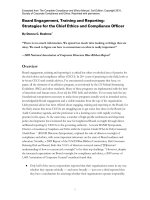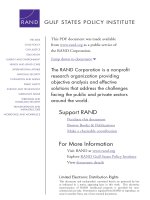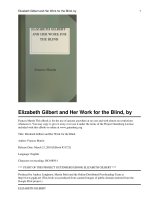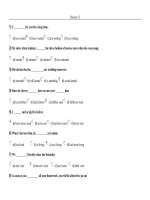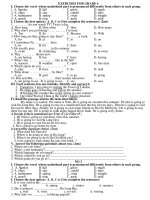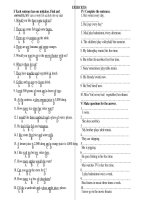2012 SBA and MTF MCQs for the final FRCA
Bạn đang xem bản rút gọn của tài liệu. Xem và tải ngay bản đầy đủ của tài liệu tại đây (5.67 MB, 250 trang )
SBA and MTF MCQs for the Final FRCA
SBA and MTF MCQs
for the Final FRCA
The FRCAQ.com Writers Group
The Severn Deanery
Dr James Nickells
North Bristol NHS Trust
Dr Ben Walton
North Bristol NHS Trust
cambridge university press
Cambridge, New York, Melbourne, Madrid, Cape Town,
Singapore, São Paulo, Delhi, Tokyo, Mexico City
Cambridge University Press
The Edinburgh Building, Cambridge CB2 8RU, UK
Published in the United States of America by Cambridge University Press, New York
www.cambridge.org
Information on this title: www.cambridge.org/9781107620537
© Cambridge University Press 2012
This publication is in copyright. Subject to statutory exception
and to the provisions of relevant collective licensing agreements,
no reproduction of any part may take place without the written
permission of Cambridge University Press.
First published 2012
Printed and bound in the United Kingdom by the MPG Books Group
A catalogue record for this publication is available from the British Library
ISBN 978-1-10762053-7 Paperback
Cambridge University Press has no responsibility for the persistence or
accuracy of URLs for external or third-party internet websites referred to
in this publication, and does not guarantee that any content on such
websites is, or will remain, accurate or appropriate.
Every effort has been made in preparing this book to provide accurate and up-to-date
information which is in accord with accepted standards and practice at the time of
publication. Although case histories are drawn from actual cases, every effort has been
made to disguise the identities of the individuals involved. Nevertheless, the authors,
editors and publishers can make no warranties that the information contained herein is
totally free from error, not least because clinical standards are constantly changing through
research and regulation. The authors, editors and publishers therefore disclaim all liability
for direct or consequential damages resulting from the use of material contained in this
book. Readers are strongly advised to pay careful attention to information provided by the
manufacturer of any drugs or equipment that they plan to use.
Contents
List of contributors
Preface
page vi
ix
QUESTION PAPERS
Paper 1
3
Paper 2
25
ANSWERS
Paper 1
49
Paper 2
50
EXPLANATIONS
Paper 1
53
Paper 2
138
Index
228
v
Contributors
The FRCAQ.com Writing Group for the Final FRCAQ.com site are:
MBChB, FRCA, Anaesthetic Trainee, Severn Deanery, Bristol, UK
DR ROBERT AXE
MRCP, BMBS(Hons), BMedSci(Hons), Anaesthetic
Trainee, Severn Deanery, Bristol, UK
DR EMMA BELLCHAMBERS
MA(OXON), MBBS, AICSM, Anaesthetic Trainee, Severn Deanery,
DR JAMES BOWLER
Bristol, UK
BSc(Hons), MBBS, FRCA, Senior Registrar, Intensive Care Unit, Royal
Perth Hospital, Western Australia
DR TIM BOWLES
DR ALICE BRAGA
MBChB(Hons), MRCP, FRCA, Anaesthetic Trainee, Severn Deanery,
Bristol, UK
BSc, MBChB, MRCP, FRCA, DICM, FICM, Consultant in Critical
Care and Anaesthesia, North Bristol NHS Trust, Bristol, UK
DR JULES BROWN
BMBS, BMedSci, FRCA, Anaesthetic Trainee, Severn Deanery,
DR HELEN CAIN
Bristol, UK
DR AMY CREES
BSc(Hons), MBChB, MRCP, Core Medical Trainee, Severn Deanery,
Bristol, UK
MBChB, MSc, DRCOG, MRCS(Eng), FRCA, Anaesthetic Trainee,
Severn Deanery, Bristol, UK
DR ALIA DARWEISH
DR JAMES EVANS
MBChB, MRCP, FRCA, Anaesthetic Trainee, Severn Deanery,
Bristol, UK
MBChB, FRCA, Consultant Anaesthetist, The Hospital for Sick
Children, Toronto, Canada
DR TOBIAS EVERETT
BSc(Hons), MBBS, MRCS, FRCA, Anaesthetic Trainee, Severn
Deanery, Bristol, UK
DR ANDREW FOO
DR DAN FRESHWATER-TURNER
MA, MBBChir, MRCP, FRCA, Consultant in
Anaesthesia and Intensive Care, University Hospitals, Bristol NHS Foundation
Trust, Bristol, UK
vi
Medico Cirujano, FRCA, Anaesthetic Trainee, Severn Deanery,
DR JUAN GRATEROL
Bristol, UK
BMBS, BMedSci, FRCA, Anaesthetic Trainee, Severn Deanery,
DR BEN GREATOREX
Contributors
MBChB, BSc(Hons), FRCA, DICM DIC, Consultant in Critical
Care and Anaesthesia, Royal United Hospital, Bath, UK
DR ANDY GEORGIOU
Bristol, UK
BMBS, BMedSci, Anaesthetic Trainee, Severn Deanery, Bristol, UK
DR RUTH GREER
BMBS, MRCP, FRCA, DICM, Anaesthetic Trainee, Severn
Deanery, Bristol, UK
DR CLARE HOMMERS
MBBS, FRCA, EDIC, Anaesthetic Trainee, Severn Deanery and
Defence Medical Services, Bristol, UK
DR TIM HOOPER
DR TIM HOWES
MBChB, FRCA, Anaesthetic Trainee, Severn Deanery, Bristol, UK
MBChB, FRCA, Consultant in Pain Medicine and Anaesthesia,
Barking, Havering and Redbridge NHS Foundation Trust, UK
DR BEN HUNTLEY
DR IZREEN IQBAL
MBChB, FRCA, Anaesthetic Trainee, Severn Deanery, Bristol, UK
DR DOM JANSSEN
BA, BSc(Med), MBBS, FRCA, Anaesthetic Trainee, Severn Deanery,
Bristol, UK
BSc(Hons), FRCA, Anaesthetic Trainee, Severn Deanery,
DR IAN KERSLAKE
Bristol, UK
DR EMMA KING
MBChB, FRCA, Anaesthetic Trainee, Severn Deanery, Bristol, UK
FRCA, MRCP, MBBCh, BSc(Hons), Anaesthetic Trainee, Severn
Deanery, Bristol, UK
DR SIOBHAN KING
MBChB, MRCS(Eng), Orthopaedic Trainee, Severn Deanery,
DR SARAH LANCASTER
Bristol, UK
DR ABBY LIND
BSc, MBChB, MRCP, FRCA, Anaesthetic Trainee, Severn Deanery,
Bristol, UK
BSc, MBChB, MRCP, FRCA, Anaesthetic Trainee, Severn Deanery,
DR CLINTON LOBO
Bristol, UK
DR HELEN MAKINS
MBBS, FRCA, Anaesthetic Trainee, Severn Deanery, Bristol, UK
MBChB, FRCA, PG Cert Adv HCP, Anaesthetic Trainee, Severn
Deanery, Bristol, UK
DR CHRIS MARSH
DR ALEX MIDDLEDITCH
MBChB, FRCA, Anaesthetic Trainee, Severn Deanery,
Bristol, UK
DR HENRY MURDOCH
BSc, MBBS, FRCA, Anaesthetic Trainee, Severn Deanery,
Bristol, UK
BSc(Hons), MBChB, MRCP(UK), Anaesthetic Trainee, Severn
Deanery, Bristol, UK
DR CHRIS NEWELL
DR JAMES NICKELLS
MBBS, FRCA, Consultant Anaesthetist, North Bristol NHS Trust,
Bristol, UK
DR SONJA PAYNE
MD, MSc, BSc(Hons), Anaesthetic Trainee, Severn Deanery,
Bristol, UK
DR ANNABEL PEARSON
Bristol, UK
BMedSci(Hons), BMBS, Anaesthetic Trainee, Severn Deanery,
vii
Contributors
MRCP, FRCA, DICM, EDIC, PGCMEd, Consultant in
Anaesthesia and Intensive Care, University Hospitals, Bristol NHS Foundation
Trust, Bristol, UK
DR KIERON ROONEY
DR SOPHIE SCUTT
DR SIMON SLINN
FRCA, MRCP, Anaesthetic Trainee, Severn Deanery, Bristol, UK
BSc(Hons), MBBCh, FRCA, Anaesthetic Trainee, Welsh Deanery, UK
MBBS, BSc ,FRCA, PGCMEd, Anaesthetic Trainee, Severn
Deanery, Bristol, UK
DR JANINE TALBOT
DR HELEN TURNHAM
MBChB(Hons), FRCA, Anaesthetic Trainee, Severn Deanery,
Bristol, UK
MBChB, MRCP, FRCA, Consultant in Critical Care and
Anaesthesia, North Bristol NHS Trust, Bristol, UK
DR BENJAMIN WALTON
DR SARAH WARWICKER
BM, BCh, MA, FRCA, Anaesthetic Trainee, Severn Deanery,
Bristol, UK
DR MARK WIGGINTON
MBBS, FRCA, Anaesthetic Trainee, Severn Deanery,
Bristol, UK
DR MARK YEATES
Bristol, UK
viii
BM, FRCA, MRCS, Anaesthetic Trainee, Severn Deanery,
Preface
You are currently holding a book containing 180 MCQ questions designed to help
you revise for the written component of the Final FRCA exam set by the Royal
College of Anaesthetists. The book provides two papers, each consisting of 90 questions, with 60 multiple true false questions (MTF) followed by 30 single best answer
questions (SBA). The split of question topic areas covers all those tested by the
College. These topic areas are basic sciences, medicine and surgery, intensive care
medicine, clinical anaesthesia and pain medicine. The papers in this book have the
correct ratio of questions from all these five disciplines and the correct proportion of
SBAs and MTFs across these disciplines. For example, each paper has five SBAs in
pain and five MTFs in pain as per the real Final FRCA paper. After the question
papers, the second section of the book provides answers and explanations for the
questions. Each question has both a short explanation that should allow the user to
determine, at a glance, why they may have selected an answer incorrectly and a long
explanation which provides more in-depth information on the topic area. The questions have been prepared by anaesthetists or experts in areas of tested knowledge
who have either recently sat the Final FRCA or have been involved in training
candidates for the exam. This book represents 180 question files from the highly
popular and successful FRCAQ.com website. This website has over 2600 question
files available, covering all areas of the Final FRCA syllabus. Access to the website is
available with a subscription at www.FRCAQ.com.
It is our experience that candidates are still more comfortable and familiar with
answering MTF questions compared to the SBA questions. SBAs were introduced in
to the Final exam in September 2010 with the idea that they test an area of understanding at a higher level than an MTF question. Traditionally, MTFs have been used
to test points of knowledge. They often have the structure of making a statement
about a specific area and asking you whether it is true or false. You have a fifty:fifty
chance of getting the answer right or wrong if you knew nothing and had a wild
guess. A typical pass mark for an MTF component of the Final FRCA MCQ paper
is 75–80%. The SBA section usually involves a clinical scenario followed by the
candidate being asked to select a best option. For example, this may be ‘Select the
best management plan’ or ‘What investigation should you perform next?’ In SBAs,
typically most of the available options are interrelated and plausible; it’s just that one
of the options is best. The pass mark for the SBA component of the exam is typically
50–55%. This should allow the mathematically astute candidate to realise that on
average you are not being asked to select the best answer. You are being asked to
ix
Preface
whittle the list of five options down to two and then have a guess between the last
two. Rather than Single Best Answer questions, they could be called ‘Discount the
Least Good Three Answers’ questions. In training people for sitting these questions,
this mindset has allowed us to teach people a very useful tactic for approaching these
questions. The key is to discount the more ridiculous options and try to pare the
options down to a small group (ideally a group of one, but two or occasionally three is
not a disaster). Once a smaller group has been identified, an educated guess within
that group will usually be sufficient to achieve an adequate score. When we first
heard the news that SBAs were being launched for anaesthetic exams we thought that
the answers would have to be based on emphatic knowledge and therefore guessed
that questions would be drawn from areas of anaesthesia in which firm guidelines
existed (such as resuscitation or the management of anaphylaxis). Subsequently it
seems that this has not been the case, with the College content to examine areas in
which controversy or differences of opinion occur. The criterion for determining the
‘correct’ answer is based on what the majority of a group of experienced anaesthetists
would choose. The controversial nature of the SBA content and the fact that only 20%
will be scored by wild guessing means that a user getting over 55% on this section of
the paper is doing extremely well.
Each part of an MTF question counts for one mark in your final score. Sixty questions
with five marks available for each contributes 300 marks to the final score. Four marks
are given for each correct SBA question, so 30 questions contributes 120 marks to the final
total of 420 available marks. If the pass mark for the SBA paper is around 50–55% and for
the MTF section is 75–80%, the combined pass mark is usually around 70%.
Our general advice for using this book would be, in the first instance, to try to sit the
two papers under as close to exam conditions as possible. Following an initial attempt
at the questions, a review of the explanations will not only act as a revision aid, but also
give some insight into how and why questions are set. If using this book has proved
valuable, please come and visit us at www.FRCAQ.com, where we have nearly fifteen
times the amount of content in this book for you to explore.
Good luck – and we look forward to seeing you at www.FRCAQ.com soon.
James Nickells and Ben Walton
Editors, FRCAQ.com
x
Question Papers
Paper 1
MTF Question 1
With regard to measurement of humidity, which of the following statements are correct?
a)
b)
c)
d)
e)
Most instruments measure absolute humidity
Regnault’s hygrometer has a silver tube containing ether
Absolute humidity can be measured by transducers
The hair hygrometer works on the principle that hair shortens as humidity increases
The wet and dry bulb hygrometer relies on the cooling effect by loss of latent heat of
vaporisation for its function
MTF Question 2
Which of the following statements regarding ketamine are true?
a)
b)
c)
d)
e)
Ketamine causes analgesia through its activity at opioid receptors
NMDA receptor antagonism is the main mechanism of ketamine effect
Ketamine blocks the release of glutamate in the CNS
Ketamine blocks activity at muscarinic receptors in the central nervous system
Like all general anaesthetic agents, ketamine has activity at the GABAA receptor
MTF Question 3
Causes of hypokalaemia include:
a)
b)
c)
d)
e)
Pyloric stenosis
Villous adenoma of rectum
Conn’s syndrome
Theophylline poisoning
Renal tubular acidosis
MTF Question 4
The physiological features of severe anorexia nervosa include:
a) Cardiomyopathy
b) Proteinuria
c) Bradycardia
3
Paper 1
d) Gastric dilation
e) Panhypopituitarism
MTF Question 5
Regarding the use of targeted temperature management after cardiac arrest:
a)
b)
c)
d)
The ideal target temperature is 30 °C
J waves are a common finding on the ECG of a patient at 31 °C
At the end of the cooling period, passive rewarming should be allowed
A heart rate of 38 beats per minute when the patient’s temperature is 32 °C is an
indication for rewarming
e) Shivering should preferentially be treated with a non-depolarising neuromuscular
blocking drug (NMBD)
MTF Question 6
Regarding gabapentin, which of the following statements are true?
a)
b)
c)
d)
e)
Gabapentin is an agonist at the γ-aminobutyric acid (GABA)A receptor
Gabapentin is metabolised by the CYP3A4 isoenzyme
Gabapentin is available in a transdermal drug delivery patch
Gabapentin can be used for the treatment of acute pain
Gabapentin enhances the action of morphine
MTF Question 7
Regarding the neuromuscular junction:
a) The synaptic cleft is 5 nanometres wide
b) There are 10 acetylcholine receptors for every molecule of acetylcholine released in
a conducted impulse
c) Nerve fibres converge on the motor end-plate of the muscle fibre
d) The terminal portion of the motor neurone is unmyelinated
e) Prejunctional acetylcholine receptors have the same morphology as the
postjunctional ones
MTF Question 8
Regarding the porphyrias:
a) They are rare acquired disorders of haem biosynthesis
b) They are rare genetic disorders of haem breakdown
c) Acute intermittent porphyria presents with neurovisceral crises and cutaneous
manifestations
d) Urine porphobilinogens are not raised between attacks in acute intermittent porphyria
e) Treatment of an acute attack includes a low-carbohydrate diet
MTF Question 9
Regarding urinary tract infection:
4
a) Gram-negative organisms are usually involved
b) It rarely causes sepsis
c) More than 100 000 organisms/mm3 on urinary microscopy is significant
Paper 1
d) Urinary catheterisation is rarely associated
e) Treatment should include urinary catheterisation
MTF Question 10
Which of the following statements regarding pharmacology in renal failure are true?
a) In acute kidney injury (AKI), the loading dose of a drug which undergoes excretion
via the renal tract may need to be increased
b) The commonest reason for AKI caused by aminoglycosides is that they cause an
interstitial nephritis
c) Imipramine is a cause of obstructive (post-renal) AKI
d) Acetazolamide is a cause of obstructive (post-renal) AKI
e) When using ketamine for analgesia, the dose should be reduced in patients with AKI
MTF Question 11
Regarding the role and location of central chemoreceptors in the control of breathing:
a) The central chemoreceptors are located near the dorsal surface of the pons
b) Central chemoreceptors respond rapidly to changes in carbon dioxide tension in
the blood
c) Central chemoreceptors respond rapidly to changes in oxygen tension in the blood
d) The pH of cerebrospinal fluid is slightly acidic compared with plasma
e) Respiratory acidosis causes a greater increase in ventilation than metabolic acidosis
MTF Question 12
With regard to the cardiovascular complications associated with obesity, which of the
following statements are correct?
a) Renal blood flow is increased in obesity
b) Cardiac arrhythmias can be caused by fatty infiltration of the conduction system
c) Obese individuals have an increased cardiac output predominantly due to an
increased heart rate
d) Absolute blood volume is increased
e) Systemic hypertension is 2 times more prevalent than in the non-obese population
MTF Question 13
With regard to critical care outreach services (CCOS), which of the following are true?
a) There is no evidence that it reduces the number of patients who have received
cardiopulmonary resuscitation (CPR) prior to ICU admission
b) There is strong (level 1A) evidence that it reduces ICU mortality
c) CCOS was introduced into the NHS without formal prospective evaluation processes
d) Early warning scores may form part of the track and trigger approach
e) Education of ward staff and junior doctors commonly forms part of its remit
MTF Question 14
Which of the following are true of hyperosmolar non-ketotic coma (HONK)?
a) It is the same as hyperosmolar hyperglycaemic state
5
Paper 1
b)
c)
d)
e)
It is more common in type 1 diabetes than in type 2 diabetes
It presents with a mild ketosis
It presents in the absence of coma
Severe hyperglycaemia causes a functional thrombocytopenia
MTF Question 15
Which of the following are recognised treatment options used in confirmed cyanide
poisoning?
a)
b)
c)
d)
e)
Dicobalt edetate
Hydroxocobalamin
Gastric lavage
Sodium nitroprusside
Sodium thiosulphate
MTF Question 16
Functional residual capacity (FRC):
a)
b)
c)
d)
e)
Can be measured using Fowler’s method
Is the sum of the residual volume and the expiratory capacity
Is a fixed volume
Exceeds the closing capacity in the elderly
May be reduced by restrictive lung disease
MTF Question 17
Which of the following statements are true regarding Turner syndrome?
a)
b)
c)
d)
e)
Patients often suffer from menorrhagia
Common clinical features include short stature
It only affects females
Mental retardation is common
Coarctation of the aorta occurs in 10% of patients
MTF Question 18
Regarding psychological techniques in pain management:
a)
b)
c)
d)
e)
There is no evidence to support psychological support in chronic pain patients
Psychological management is helpful to cure chronic pain conditions
Cognitive behavioural therapy challenges maladaptive thinking patterns
Encouraging patients to pace their activity facilitates coping with chronic pain
Psychological techniques encourage malingering behaviour
MTF Question 19
Which of the following statements regarding community-acquired pneumonia (CAP)
are true?
6
a) A chest radiograph is necessary to make the diagnosis
b) Urea and electrolytes (U&E) offers important prognostic information
Paper 1
c) The white blood cell (WBC) count is an important prognostic determinant in nonimmunosuppressed patients
d) Staphylococcus aureus is the most common causative organism
e) Macrolides should be discontinued in patients admitted to intensive care if the
atypical pneumonia screen is negative
MTF Question 20
The following are true of the use of clonidine in critical care:
a)
b)
c)
d)
e)
It is predominantly a postsynaptic α2-adrenoreceptor agonist
It has an oral bioavailability approaching 100%
On starting the medication it may cause initial, short-lived, hypertension
It can be stopped abruptly without a reducing dosage regime
It is the first-line treatment for agitation in a recently extubated patient with
traumatic brain injury and established acute alcohol withdrawal
MTF Question 21
Regarding current religious rulings and cultural attitudes to brainstem death in the
UK, which of the following statements are true?
a) It is considered haraam (forbidden) for Muslims to become heart-beating organ donors
b) Orthodox Jewish law, Halacha, accepts brainstem death as comparable to
cardiorespiratory death
c) Shariah (Islamic) law representatives in the UK consider brainstem death to be a true
definition of death
d) Buddhist doctrine does not accept brainstem death to be a true definition of death
e) Brainstem death is still considered legal in the UK even if the patient’s family reject
the diagnosis on religious grounds
MTF Question 22
Concerning the pipeline medical gas supply to theatres:
a) Medical oxygen is supplied at a pressure of 4 bar via a white coloured hose
b) Air is supplied via a black and white hose at a pressure of either 4 or 7 bar
c) The pipeline gas distribution network upstream of the wall terminal outlets is made
of reinforced PVC with an antistatic core
d) Each Schrader valve has a similar external diameter irrespective of the gas pipeline
that ends at it
e) By law it must be possible to disconnect a hose from a Schrader valve using one
hand only
MTF Question 23
Which of the following statements regarding local anaesthetics are true?
a)
b)
c)
d)
e)
Ester and amide local anaesthetic agents have exactly the same mechanism of action
Local anaesthetic agents are weak acids
A local anaesthetic agent with a low pKa will have a fast onset of activity
Local anaesthetic agents only work after being ‘trapped’ inside nerve cells
Local anaesthetic agents preferentially bind to sodium channels in their open state
7
Paper 1
MTF Question 24
Which of the following statements about the intercostal nerves are correct?
a) The intercostal nerves contain sensory, motor and autonomic fibres
b) The intercostal nerves supply the skin over the sternum and over the spine
c) The intercostal nerves run between the internal intercostal muscle and the
transversus thoracic muscle
d) Paravertebral block will provide adequate analgesia for a rib fracture
e) A chest drain should be inserted at the inferior aspect of the intercostal space
MTF Question 25
The following are features suggestive of carcinoid syndrome:
a)
b)
c)
d)
e)
Diarrhoea
Hypertensive episodes
Facial flushing
Dementia
Wheeze
MTF Question 26
When performing an arterial blood gas, which of the following are true?
a)
b)
c)
d)
e)
Excess heparin in the syringe will make the sample more acidic
Carbon dioxide levels are measured by changes in electrode pH
Air bubbles in the sample increase the carbon dioxide partial pressure
A pH of 7.4 is equivalent to 40 mmol/L of hydrogen ions
A sample kept at room temperature has a lower hydrogen ion concentration
MTF Question 27
Which of the following statements regarding the Glasgow Coma Scale (GCS) are true?
a)
b)
c)
d)
A decorticate response to stimulus will score 2 on the motor component
Moaning in pain will score 2 on the voice component
A sternal rub is an appropriate painful stimulus
With asymmetrical limb movement, the best limb should be scored for the motor
component
e) The original Glasgow Coma Scale was scored out of 14
MTF Question 28
Which of the following cause a rise in end-tidal carbon dioxide?
a)
b)
c)
d)
e)
8
Pulmonary embolism
Hypovolaemia
Hyperthermia
Sepsis
Flow rates of less than 150 mL/kg/min using a coaxial Mapleson D circuit during
spontaneous ventilation
Regarding renin:
a) Renin is released from the macula densa in response to a decrease in circulating
volume
b) Release is inhibited by angiotensin II
c) Sympathetic stimulation, via activation of α-adrenoreceptors, stimulates renin
release
d) Release is stimulated by atrial natriuretic peptide
e) Renin directly stimulates the release of vasopressin
Paper 1
MTF Question 29
MTF Question 30
Regarding magnesium:
a) Magnesium is the second most abundant extracellular cation
b) Magnesium antagonises N-methyl-D-aspartic acid (NMDA) receptors in the central
nervous system
c) The biggest stores of magnesium in the body are in the skeleton
d) Magnesium is a cofactor for Na+/K+-ATPase
e) Hypomagnesaemia may produce cardiac arrhythmias similar to those caused by
hypokalaemia
MTF Question 31
With regard to the diagnosis and treatment of gestational hypertension:
a) Oral hydralazine should be commenced as first-line treatment
b) Gestational hypertension is defined as a sustained sitting blood pressure
> 140/90 mmHg occurring after 20 weeks gestation
c) Gestational hypertension is defined as an increase in systolic blood pressure
≥ 30 mmHg or diastolic blood pressure ≥ 15 mmHg occurring after 20 weeks gestation
d) Oral labetalol at a dose of 50–100 mg twice daily is appropriate initial treatment
unless there are contraindications
e) Amlodipine is an acceptable alternative to nifedipine to treat gestational
hypertension
MTF Question 32
Regarding the cranial vault in a healthy adult:
a)
b)
c)
d)
e)
The mass of a human brain is approximately 1000 g
Brain parenchyma occupies 85% of the cranial volume
Volume of cerebrospinal fluid in the cranial vault is 150 mL
Blood occupies 7% of cranial vault volume
Early compensation for raised intracranial pressure (ICP) includes reduced
production of cerebrospinal fluid
MTF Question 33
Regarding pyloric stenosis:
a) It is more common in females
b) Metabolic acidosis is common
c) Surgery must be performed immediately upon diagnosis
9
Paper 1
d) It usually presents in the first week of life
e) Blood results typically show a hypokalaemic, hyperchloraemic metabolic alkalosis
MTF Question 34
Which of the following statements about desflurane are true?
a)
b)
c)
d)
e)
Desflurane has a lower blood: gas partition coefficient than nitrous oxide
Desflurane increases the risk of haemorrhage during obstetric procedures
Desflurane increases respiratory secretions and may cause bronchospasm
Desflurane is likely to cause bradycardia if used at high concentrations
Desflurane requires a special vaporiser because it is unstable at room temperature
MTF Question 35
Regarding Duchenne muscular dystrophy (DMD):
a)
b)
c)
d)
DMD presents from early childhood and is progressive
DMD occurs equally in both sexes
Genetic counselling is recommended
Calf hypertrophy with lower motor neurone signs and restrictive lung function
deficit are indicative of DMD
e) Diagnosis is confirmed by response to steroid therapy and plasmaphoresis or
immunoglobulin infusion
MTF Question 36
Which of the following statements regarding the internal jugular vein are correct?
a)
b)
c)
d)
The internal jugular vein drains the sigmoid sinus
The internal jugular vein joins the subclavian vein posterior to the clavicle
The internal jugular vein begins at the foramen lacerum at the base of the skull
Horner’s syndrome is a recognised complication of attempted cannulation of the
internal jugular vein
e) The internal jugular vein is valveless
MTF Question 37
A 17-year-old girl is admitted to the emergency department with collapse following a
2-day history of vomiting. On examination she is slim, with patches of vitiligo. She is
currently haemodynamically stable. Blood tests reveal sodium 129 mmol/L, potassium 6.9 mmol/L, urea 5.2 mmol/L, creatinine 89 μmol/L. ECG shows sinus rhythm
with peaked T waves. Ideal initial management should include:
a)
b)
c)
d)
e)
Intravenous hydrocortisone
Salbutamol nebuliser
Short adrenocorticotrophic hormone (ACTH) stimulation test
Calcium gluconate
Intravenous glucose and insulin infusion
MTF Question 38
10
Which of the following statements relating to an amniotic fluid embolism (AFE) are
correct?
A maternal age of < 20 years makes the diagnosis of AFE more likely
A simple blood test can be performed to confirm the diagnosis of AFE
Pulmonary oedema leading to hypoxaemia is often seen in AFE
Coagulopathy is uncommon in AFE
The majority of cases occur in the immediate post-partum period
Paper 1
a)
b)
c)
d)
e)
MTF Question 39
Regarding botulism, which of the following are true?
a) Clostridium botulinum is a Gram-negative anaerobic rod
b) Patients with botulism caused by wound infections should be treated with
penicillin
c) Botulinum toxin blocks presynaptic release of acetylcholine
d) Patients present with flaccid paralysis and autonomic dysfunction
e) Botulinum antitoxin should be given to reverse the muscle weakness
MTF Question 40
Which of the following statements about the pharmacokinetics of drugs in patients
following major trauma are correct?
a) Drugs administered via nasogastric tube have the same absorption kinetics as if
they were taken orally
b) Hepatic enzyme activity is decreased following major trauma by the activity of
pro- and anti-inflammatory cytokines
c) A patient anticoagulated with warfarin can expect to require a lower dose to
maintain the same INR after major trauma
d) The volume of distribution of water-soluble drugs increases after major trauma
e) After head injury, brain levels of most drugs will increase
MTF Question 41
Regarding the impact of occupational, environmental and socioeconomic factors on
critical illness:
a) Alcohol-related deaths are more frequent in males than in females
b) Patients from lower socioeconomic backgrounds have a higher incidence of
obstructive sleep apnoea than the general population
c) Low socioeconomic status is associated with worse long-term survival after critical
illness, after adjusting for effects of age, severity of illness and comorbidities
d) Patients with a history of drug dependence are at increased risk of delirium in
intensive care
e) Where patients with alcohol dependence require supplemental enteral
nutrition, protein restriction is recommended to reduce the risk of hepatic
encephalopathy
MTF Question 42
Regarding human lymphatics, which of the following statements are true?
a) The adult flow of lymph is 2–4 L/h
b) Collecting lymphatics have smooth muscle in their walls and have valves
11
Paper 1
c) Entrainment promotes lymph flow
d) Radical mastectomy and axillary node clearance results in upper-limb
lymphoedema in 50% of patients
e) In a test tube, pure lymph will clot
MTF Question 43
Regarding drug prophylaxis in migraine, which of the following are considered firstline treatment?
a)
b)
c)
d)
e)
Atenolol
Propanolol
Bisoprolol
Amitriptyline
Nortripyline
MTF Question 44
Which of the following are true in relation to the use of ultrasound in clinical
practice?
a) Increased frequency of ultrasound during B-mode scanning results in higherresolution scans
b) There is no risk of damage to red blood cells with Doppler ultrasound scanning
c) The use of Doppler in conjunction with standard ultrasound imaging reduces the
risk of damage to tissues by cavitation
d) Increased frequency of ultrasound results in greater depth of tissue penetration
e) The heating effect of ultrasound fields is more marked in bone compared to soft
tissues
MTF Question 45
Which of the following are part of the definition of the systemic inflammatory response
syndrome (SIRS)?
a)
b)
c)
d)
e)
Heart rate > 100 beats/minute
Systolic blood pressure < 100 mmHg
Respiratory rate > 20 breaths/minute
Temperature < 36 °C
White blood cell count < 4000 cells/mm3
MTF Question 46
Regarding sphincters:
12
a) The lower oesophageal sphincter maintains a tonic constriction producing
intraluminal pressure of 30 mmHg
b) Pre-capillary sphincters are located at the junction of arterioles and metarterioles
c) The pyloric sphincter poses little resistance to the passage of fluids
d) The sphincter of Oddi is located at the junction between the cystic duct and the
duodenum
e) The internal bladder sphincter is innervated by the pudendal nerve
In combined data from placebo versus drug trials, which of the following produced no
significant risk reduction for postoperative nausea and/or vomiting (PONV)?
a)
b)
c)
d)
e)
Paper 1
MTF Question 47
Magnesium
Glycopyrrolate
Metoclopramide
Ginger
Clonidine
MTF Question 48
Regarding inflammation:
a)
b)
c)
d)
e)
Vasodilation is mediated by bradykinin
Increased vascular permeability inhibits the inflammatory response
Histamine increases vascular permeability
Chemotaxis is the process that limits the inflammatory response
Prostaglandin E2 mediates vasodilation
MTF Question 49
Regarding hereditary angio-oedema:
a)
b)
c)
d)
e)
It results from a disorder with complement
It has an autosomal dominant inheritance pattern
The majority of attacks occur spontaneously
Treatment options include administration of fresh frozen plasma
Upper airway obstruction is rarely a problem
MTF Question 50
A 48-year-old asthmatic patient is reviewed in preoperative assessment clinic prior to
admission for cholecystectomy in 4 weeks. He has spirometry showing FEV1 1.2L, FVC
2.5L (predicted 2.6/3.2). He has had nightly symptoms for a week, but on clinical
examination he is not distressed. His medication includes fluticasone 250 g bd and
salmeterol 50 g bd. The likely management needed prior to surgery includes:
a)
b)
c)
d)
e)
Admission for intravenous hydrocortisone
Addition of a leukotriene receptor antagonist to his medication
Specialist review
Commencement of antibiotics
Increase in his inhaled steroid medication
MTF Question 51
Concerning open fractures:
a)
b)
c)
d)
Approximately 25% of tibial fractures are open fractures
Intravenous antibiotics should be commenced within 6 hours of the acute injury
All open fractures should be debrided within 6 hours of the injury
Up to 30% of patients with an open fracture will develop a significant infection
following the injury
13
